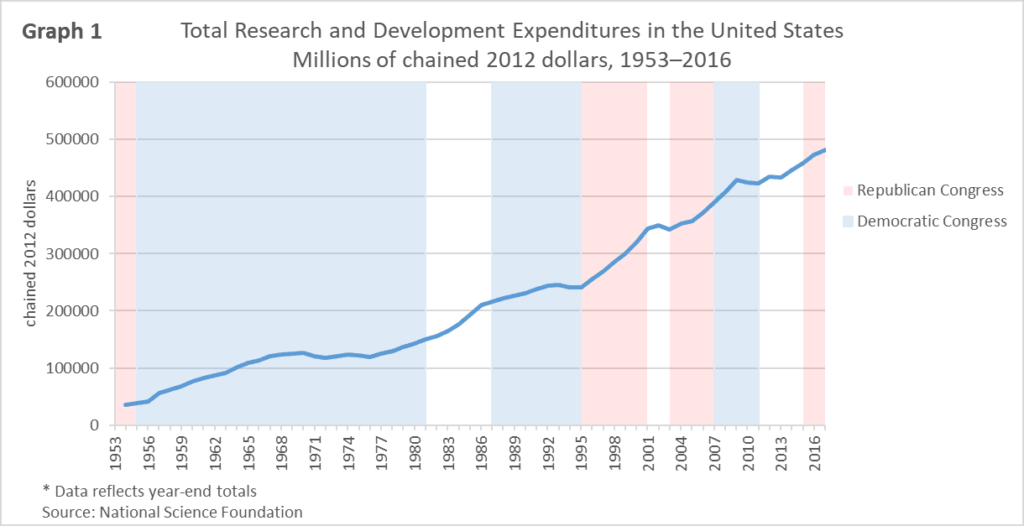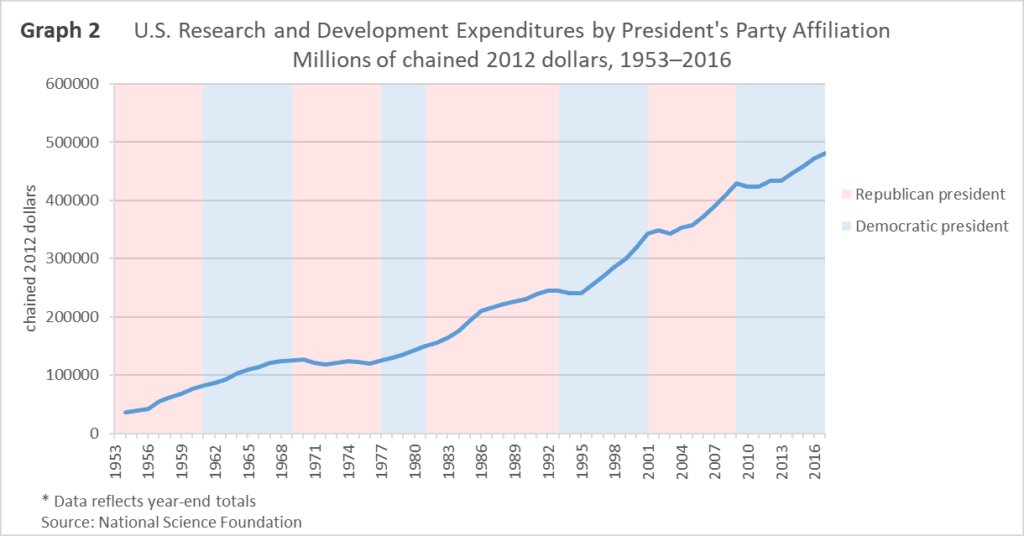A Democratic House could hurt science spending
Still, future funding for scientific research remains uncertain. Historical statistics on science-related spending show a statistically significant correlation between Democratic control of Congress and total research and development expenditures. The correlation is negative.
This negative correlation stays strong and obvious even after accounting for other variables, such as which party held the presidency, whether there was divided government, whether the country was at war and whether there was a recession. Moreover, the negative correlation holds across all three subdivisions of research and development spending—basic research, applied research and development.
Graph 1 shows inflation-adjusted annual research and development expenditures against the party makeup of Congress. Unshaded segments are years with a split Congress.

The expenditure line tends to flatten during years with a Democratic Congress but spike when Republicans control both houses. The relation is less clear when each party controls one chamber. While a simple regression suggests a split Congress helps to stimulate research and development spending, a more sophisticated analysis suggests other factors account for this effect. One explanation could be the previous balance of Congress. Of the three ranges with a split Congress, the two periods with growing science expenditures—the 1980s and the 2010s—came after Democrats controlled both chambers, while the stagnation in 2001 and 2002 came between growth periods during Republican-controlled terms.
This is not to suggest that the Democrats are anti-science in practice. Nor should we say the Republicans are the unwitting party of science. The data also suggest that having a Republican in the White House decreases annual research and development expenditures, a relation represented in Graph 2 below. Still, the size of the change is less and the strength of the correlation is weaker than that between science spending and the party controlling Congress, which makes sense, given the Congress’s power of the purse.

These trends add another wrinkle to the future of science funding. Earlier this year, President Donald Trump and Congress approved the largest federal research spending increase in a decade. Yet the percentage of federal outlays going to general science, space and technology research has declined consistently since the early 1990s. This fits with the broader trend of the government shifting the federal budget’s focus from public goods in favor of social insurance programs. Since 1953, between 76.2 and 95.5 percent of the federal budget has consisted of social insurance programs and public goods. In 1953, 83 percent of those outlays went toward public goods. In 2017, the split was 21 percent toward public goods versus 79 percent toward social insurance.
Physicists Robert K. Adair and Ernest M. Henley have called scientific research “the seed corn of the technological innovations that sustain modern society.” Pressing problems, such as epidemics and environmental stability, demand this research. And our most audacious projects, such as breakthrough therapies and space travel, require it. Yet less than 1 percent of the country’s GDP goes toward basic science.
Moreover, the American public generally supports funding for scientific research. More than 80 percent of Americans consider research spending very or somewhat important, while 63 percent agree that the government should support basic research with no immediate benefits, according to Research!America/Zogby Analytics polls conducted in 2018 and 2017, respectively.
Science seems to be a winning issue with promises of future economic and standard-of-living gains. Whether Democrats counter history and help fund it next session is another question.









